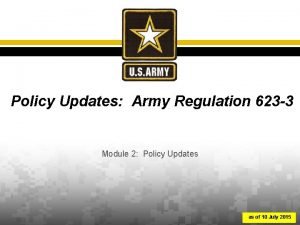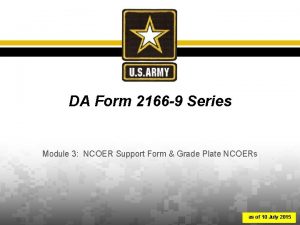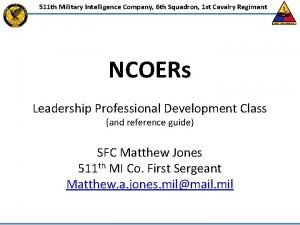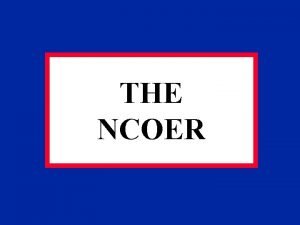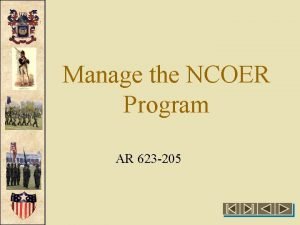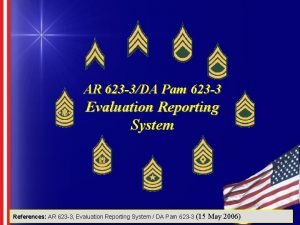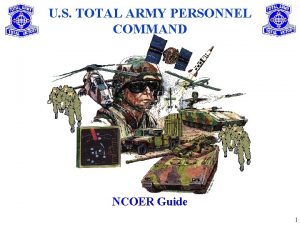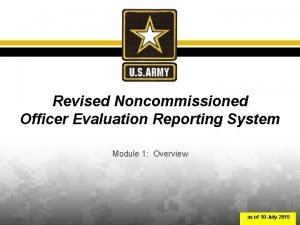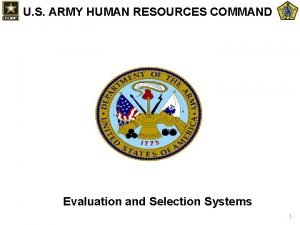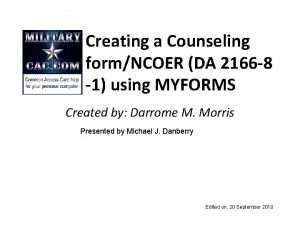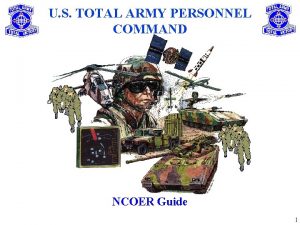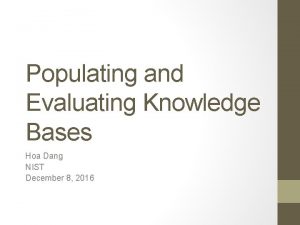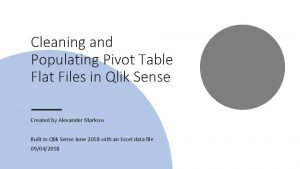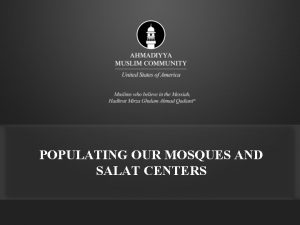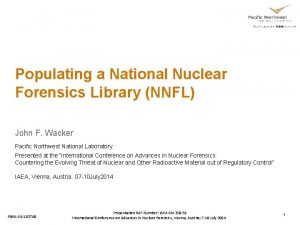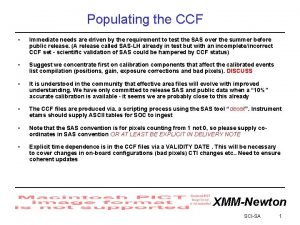Populating the NCOER SUPPORT FORM DA Form 2166









































- Slides: 41

Populating the NCOER SUPPORT FORM DA Form 2166 -9 -1 A (DA 2166 -8 -1) “Counseling NCOs” PRODUCT CREATED BY: Brock J. Young Brock. j. young. mil@mail. mil “Pride, Honor, Discipline” CURRENT VERSION DATE: v 4 20150516

NCOER SUPPORT FORM (New)

NCOER SUPPORT FORM This Power. Point is for assistance in developing: • The Daily Duties and Scope (Part III, a-c); • Areas of Special Emphasis (Part III, d); • Additional Duties (Part III, e); • Performance Goals and Expectations (part IV). Of the NCOER Support Form, and thus, the NCOER. STRESS: This is “A” way to do this, not “the” way.

NCOER SUPPORT FORM Additional Training • For technical instructions on how to fill out the NCOER Support Form using the Evaluation Entry System (ESS), please refer to instructions and classes available at the following locations: • Mil. Book: https: //www. milsuite. mil/book/docs/DOC-201132 • Human Resources Home Page: https: //www. hrc. army. mil/TAGD/Evaluation%20 Systems%20 H omepage

NCOER SUPPORT FORM Content • References • Counseling: Initial and Follow-Up • Why Use the NCOER Support Form • By the Book: Purpose and Process • Duty Description (Part III) • Rated NCO Performance Goals And Expectations (Part IV) • Performance Evaluation: Developing Performance Objectives to set NCOs up for success (Part V) • Army Leadership Requirements Model • Tips, Tricks, and TTPs for counsling NCOs • Army Professional Forums (Info and Links)

NCOER SUPPORT FORM References • ADP 1, The Army • ADRP 1, The Army Profession • ADRP 6 -22, Army Leadership • ADRP 7 -0, Training Units and Developing Leaders • AR 27 -10, Military Justice • AR 350 -1, Army Training and Leader Development • AR 600 -9, The Army Body Composition Program • AR 600 -20, Army Command Policy • AR 623 -3, Evaluation Reporting System • ATP 6 -22. 1, The Counseling Process • DA Pam 611 -21, Military Occupational Classification and Structure • DA Pam 623 -3, Evaluation Reporting System • FM 6 -22, Army Leadership; Competent, Confident, and Agile • TC 7 -22. 7, Noncommissioned Officer Guide

NCOER SUPPORT FORM STOP!! Return to the Reference page. If you have not downloaded each publication on the reference page, go to the following and do so: http: //www. apd. army. mil/ It is STRONGLY recommended that this process not continue until you have done all of the current reference material.

NCOER SUPPORT FORM Counseling Initial Counseling: Create developmental tasks that target performance objectives, specify the desired result, be measurable/ verifiable, and specify target completion date/time frame. The discussion will also include the relationship of the duty description and objectives with the organization’s mission, problems, priorities, and similar matters. Follow-up Counseling: Focus is on telling the rated NCO’s performance based on observed actions and demonstrated behavior/results; discusses what was done well/ what could be done better. Guide is the standards established in the initial/ previous counseling session(s).

NCOER SUPPORT FORM Support Form For Counseling Why use the NCOER Support Form? • Initial and follow-up counseling between the rater and the rated Soldier that is documented on the support forms (OER and NCOER) assures a verified communication process throughout the rating. • E. G. Counseling of NCOs on a DA 2166 -9 -1 A (2166 -8 -1) is required per AR 623 -3. • Using an NCOER Support Form assists with the writing of the NCO’s NCOER. NOTE: DA Form 4856, Developmental Counseling Form, is still used for event oriented (positive and negative) counseling of NCOs, and can also be used for an initial counseling in addition to the NCOER Support Form.

NCOER SUPPORT FORM By The Book Reference: DA PAM 623 -3, Par 3 -1 3– 1. Purpose and process for DA Form 2166– 8– 1 a. Purpose. • Contribute to improved performance and professional development through emphasis on performance counseling. • Rater uses the NCOER Support Form to prepare/ conduct/ record results of counseling. • Use is mandatory for all NCOs, corporal (CPL) through command sergeant major (CSM) (no NCOER is prepared for CPLs). • Purpose of the NCOER Support Form is to improve performance counseling by providing structure and discipline to the process.

NCOER SUPPORT FORM By The Book b. Process. • Within first 30 days of the rating period/ effective date of lateral appointment to CPL, or promotion to sergeant (SGT). • Rater will discuss and establish goals to promote/ support a healthy workplace environment conducive to the growth and development. • Discuss/ establish goals for supporting the EO/EEO, and SHARP. • Primary focus of initial session is standards; specifically what is expected of NCO during the rating period. • Rater shows rating chain and complete duty description. • Discusses meaning of the values and responsibilities on the NCOER, and explains the standards for success. • Rater will record key points that were discussed and obtain the rated NCO’s initials on DA Form 2166– 8– 1.

NCOER SUPPORT FORM Duty Description Part III consists of: a. Principal Duty Title. b. Duty MOSC c. Daily Duties and Scope d. Areas of Special Emphasis e. Appointed Duties

NCOER SUPPORT FORM Duty Description Part III a. Principal Duty Title: • The Rated NCO’s duty title; e. g. Team Leader, Squad Leader, Platoon Sergeant, Motor Sergeant, etc. b. Duty MOSC (military occupational specialty code): • Based on the Principal Duty Title, this will be the rated NCO’s DUTY MOS (not their current or primary MOS); e. g. 31 B 2 O, 31 B 3 O, 31 B 4 O, 91 B 3 O, etc. This should also include any ASI/SQI required for the position.

NCOER SUPPORT FORM Duty Description Part III c. Daily Duties and Scope: Must be factually correct. The duty description— • Is an outline of the NORMAL requirements of the specific duty position. • Should show required/ routine duties, not frequently changing tasks. • Essential to performance counseling and evaluation; is used to tell the NCO what the duties of the position are and what needs to be emphasized. • May be updated during the rating period. • Is used at the end of the rating period to record what was important about the duties.

NCOER SUPPORT FORM Duty Description Part III c. Daily Duties and Scope (continued): • Enter as a series of phrases, starting with action words, separated by semicolons, and ending in a period. • Use the present tense to identify what the rated NCO is supposed to do in his or her duty position. • Will be used on the NCOER • Scope should include the number of people supervised, equipment, facilities, dollars involved, and any other routine duties and responsibilities critical to mission accomplishment. NOTE. For AGR Soldiers, enter both assignments/ titles, e. g. “Squad Leader / Readiness NCO (AGR)”

NCOER SUPPORT FORM Duty Description Part III c. Daily Duties and Scope (continued). EXAMPLE: Serves as Squad Leader for a Combat Support MP Company; trains, leads, supervises, counsels, enforces standards and disciplines of 3 MP teams containing 10 junior enlisted and 3 NCOs in support of battlefield operations and law and order operations; assist the Platoon Leader in support of platoon tasks; ensures maintenance and accountability of 4 M 1151 platforms and equipment in excess of $1 million dollars.

NCOER SUPPORT FORM Duty Description Part III d. Areas of Special Emphasis (continued): • Should include the MOST IMPORTANT items that applied at any time during the rating period. • Enter areas of special emphasis and/ or appointed duties as list of tasks and/ or duties, separated by semicolons, ending with a period; e. g. Motor Sergeant; Platoon Physical Fitness NCOIC; etc. NOTE. For AGR Soldiers, enter items for both assignments/ titles.

NCOER SUPPORT FORM Duty Description Part III d. Areas of Special Emphasis (continued). EXAMPLES: Pre-deployment Training; Safety; Detainee Operations; Army Warrior Training. Platoon/Company Marksmanship Instructor; Physical Security checks for platoon/company; Provost Marshal Activities. NOTE: For anything placed in the box “III, e. ”, though not required, there SHOULD BE a corresponding “accomplishment” bullet on the back of the NCOER/ NCOER Support Form.

NCOER SUPPORT FORM Duty Description Part III e. Appointed Duties: • Enter duties appointed to the NCO not normally included in the duty description. NOTE. For AGR Soldiers, enter items for both assignments/ titles. NOTE: For anything placed in the box “III, e. ”, though not required, there SHOULD BE a corresponding “accomplishment” bullet on the back of the NCOER/ NCOER Support Form.

NCOER SUPPORT FORM Duty Description Part III e. Appointed Duties (continued). EXAMPLES: Convoy Commander in support of OIF. Escort 1; Block NCO; Operations NCO; EO/EEO NCO. Traffic Investigator; Unit Prevention Leader (UPL). Resilience Trainer Assistant (RTA). Physical Security NCO; Unit Prevention Leader.

NCOER SUPPORT FORM Parts IV and V; Note Bullets: • No change to bullet format from “old” NCOER/ NCOER Support forms: • “o” and then a space for bullet • start bullet with lower case letter, unless it’s a proper noun (name) that is usually capitalized • Up to two lines of text • One space between bullets • Start with pronouns (his, her), or action verbs • No “. ” (period) at the end of bullets (***check local unit/CSM guidance)

NCOER SUPPORT FORM Rated NCO Performance Goals And Expectations Part IV PART IV – Performance Goals and Expectations. • This is where the RATED NCO will annotate THEIR performance goals and expectations for this rating period. EXAMPLES: o attend Advanced leaders course, graduating in the top 20% o improve personal APFT scores to a minimum of 90 points per event o platoon leadership will assist and resource the training of squad to compete in the Best Warrior Competition

NCOER SUPPORT FORM Developing Performance Objectives Part V

NCOER SUPPORT FORM Part V, a. – f. Developing Major Performance Objectives, Part V: • This is developed by the rater. • Developed from: • Rated NCO’s initial counseling and expectations. • Rater’s Support Form (OER or NCOER). • Upcoming events/training. • Mandatory requirements (see next slide) • Should support next higher’s mission/ feed next higher’s eval. • Should clearly explain/define what a “Met Standard” box check looks like on an NCOER.

NCOER SUPPORT FORM Part V, a. – f. Major Performance Objectives, Part V, (continued): Mandatory Requirements, Special Interest Items (SII) : • • • Per AR 623 -3, para 3 -5, there are many “mandatory” SII that need to be included as objectives on all NCOER Support Forms, however are not expected to be reflected on the NCOER (except for those defined as being required). Also, CDRs may establish their own SII and performance objectives. SII objectives required on ALL NCOER Support Forms: • Objectives related to safety; • Objectives related to individual and unit deployment readiness; • Energy-informed actions and conservation (see para 3 -5 (k)); • Objectives in support of behavioral health goals; • Objectives in support of the EO and EEO programs; • Objectives that foster and support the SHARP Program. For additional SII, see AR 623 -3, para 3 -5, b. , (2), (a)-(k).

NCOER SUPPORT FORM Part V, a. – f. Major Performance Objectives, Part V, (continued): Making Performance objectives “SMART”; Specific, Measurable, Attainable, Relevant, Time-Bound: • In order to give your subordinate the best chance at success and meeting/exceeding your objectives, with qualitative and quantifiable accomplishments, objectives should meet all or most of the following: • Specific: Objective is clear and unambiguous. What do you want NCO to accomplish? Why; specific reasons, purpose or benefits? • Measurable: How much? How many? How will I know when it is accomplished? Indicators should be quantifiable. • Attainable: Is objective realistic based on other constraints? • Relevant: Does the objective matter? Is this the right NCO? • Time-Bound: Time frame to accomplish objective; e. g. “by end of rating period, ” or “by next APFT, ” or “by next counseling. ” • SET YOUR NCOS UP FOR SUCCESS, set them up with SOLID performance objectives.

NCOER SUPPORT FORM Part V, a. – f. o know, understand enforce the standard; both Army regulation and the Platoon Leader’s philosophy (initial counseling) Performance Objective example for “Character, ” taken from the NCO’s initial counseling: o know, understand enforce the standard; both Army regulation and the Platoon Leader’s philosophy

NCOER SUPPORT FORM Part V, a. – f. o know, understand enforce the standard; both Army regulation and the Platoon Leader’s philosophy o do not tolerate discrimination, sexual assaults, or harassment in any form; push subordinates to do the same (PL’s philosophy) Performance Objective example for “Character, ” taken from the PL’s Philosophy: o do not tolerate discrimination, sexual assaults, or harassment in any form; push subordinates to do the same (this would be an example of a mandatory SII objective)

NCOER SUPPORT FORM Part V, a. – f. 70 70 70 18% o achieve squad APFT average of 210 points, with no failures, by April APFT (initial counseling) Performance Objective examples for “Presence, ” taken from the initial counseling: APFT goals for NCO are shown as 70 points per event, and 18% BF on next APFT, with a performance objective of: o achieve squad APFT average of 210 points, with no failures, by April APFT

NCOER SUPPORT FORM Part V, a. – f. o prepare team to deploy and succeed during next quarter’s HRF validation exercise • Performance Objective example for “Achieves, ” taken from upcoming unit events (in this case an upcoming exercise): o prepare team to deploy and succeed during next quarter’s HRF validation exercise • All boxes (a. – f. ) are filled in the same way, until you have 3 bullets per box. • Again, the purpose of well defined “Performance Objectives” are to show the rated NCO what a “Met Standard” box check looks like on their future NCOER. Knowing how to “meet” the standard then allows the NCO to know how to EXCEED the standard. • Again, SET YOUR NCOS UP FOR SUCCESS, set them up with SOLID performance objectives.

NCOER SUPPORT FORM Army Leadership Requirements Model But, what do the “new” sections mean? • The sections of the “new” NCOER/NCOER support form are based off of the Army Leadership Requirements Model (ADRP 6 -22, parts 2 and 3); The information on the following slides can also be found on pages 4 and 5 of the “NEW” NCOER Support form.

NCOER SUPPORT FORM Army Leadership Requirements Model CHARACTER: Is essential to successful leadership. Elements internal and central to a leader‘s core are: -Army Values – Values are principles, standards, or qualities considered essential for successful leaders, to include adhering to/ promoting SHARP Program. Assessment should identify, any significant actions/ contributions the rated officer /NCO made toward— (1) Promoting personal and professional development of subordinates; (2) Ensuring the fair, respectful treatment of unit personnel; and (3) Establishing a workplace and overall command climate that fosters dignity and respect for all members of the unit, OR failure to do so. -Empathy – Ability to experience another person’s point of view; identify with/understand another person’s feelings and emotions; desire to care for and take care of Soldiers and others. -Warrior Ethos/Service Ethos – Shared attitudes & beliefs that embody the spirit of the Army profession. -Discipline – Control of one’s own behavior; obey and enforce good orderly practices in administrative, organizational, training, and duties.

NCOER SUPPORT FORM Army Leadership Requirements Model PRESENCE: Sum of leader’s outward appearance, demeanor, actions and words, illustrating through presence that they care. Inspiring through shared hardships and dangers; being where subordinates perform duties. Effectiveness is dramatically enhanced by understanding and developing the following areas: -Military and professional bearing – Possessing a commanding presence. Projecting a professional image of authority. -Fitness – Having sound health, strength, and endurance that support one’s emotional health and conceptual abilities under prolonged stress. -Confidence – Projecting self-confidence and certainty in the unit’s ability to succeed in its missions. Demonstrating composure and outward calm through control over one’s emotions. -Resilience – Showing a tendency to recover quickly from setbacks, shock, injuries, adversity, and stress while maintaining a mission and organizational focus.

NCOER SUPPORT FORM Army Leadership Requirements Model INTELLECT: Intellect draws on conceptual abilities; effective problem solving; sound judgment; able to reason analytically, critically, ethically, with cultural sensitivity; consider intended/ unintended consequences; anticipate second/third-order effects. Components affecting intellect: -Mental agility – Flexible; can break habitual thought patterns; anticipate/ adapt to uncertain/ changing situations; think through outcomes when decisions/ actions are not producing desired effects. Can apply multiple perspectives/ approaches. -Sound judgment – Assess situations and draw conclusions; tendency to form sound opinions, make sensible decisions/ reliable guesses; ability to assess strengths/ weaknesses of subordinates, peers, and enemy to create appropriate solutions/ action. -Innovation – Creativity in producing ideas and objects that are both novel and appropriate. -Interpersonal tact – Sensing how to interact effectively; recognizing diversity and displaying self-control, balance, and stability. -Expertise – Has logical understanding in relevant areas.

NCOER SUPPORT FORM Army Leadership Requirements Model LEADS: Direct leaders influence others person-to-person (team leaders). Organizational and strategic leaders use indirect means of influence. Leaders use several influence methods that reduce resistance and fall along a continuum between compliance and commitment: -Leads others – Motivate, inspire, and influence others to take initiative, work toward a common purpose, accomplish critical tasks, and achieve organizational objectives. -Builds trust – Mediate relationships, encourage commitment; build respect. -Extends influence beyond the chain of command – Use indirect means of influence: diplomacy, negotiation, mediation, arbitration, partnering, conflict resolution, consensus building, and coordination. -Leads by example – Be a role model; maintain standards; provide effective examples through actions; model the Army Values and reinforce verbal guidance through demonstration of commitment and action. -Communicates – Communicate effectively; express ideas; actively listen to others. Communication is essential to all other leadership competencies.

NCOER SUPPORT FORM Army Leadership Requirements Model ACHIEVES: Leadership builds effective organization. Effectiveness directly relates to the core leader competency of getting results. From the definition of leadership, achieving focuses on accomplishing the mission. Mission accomplishment co-exists with an extended perspective towards maintaining and building the organization‘s capabilities. Achieving begins in the short-term by setting objectives. In the long-term, achieving requires getting results in pursuit of those objectives. Getting results focuses on structuring what needs to be done to produce consistent results. Getting results embraces all actions to get the job done on time and to standard: -Gets results – A leader’s ultimate purpose is to accomplish tasks and achieve results. A leader gets results by providing guidance and managing resources, as well as performing the other leader competencies. Gets results focuses on consistent and ethical task accomplishment through supervising, managing, monitoring, and controlling the work.

NCOER SUPPORT FORM Army Leadership Requirements Model DEVELOPS: Has future focus; sets priorities; weighs competing demands; and steers organization’s efforts to address short and long term goals. Account for other demands that vie for an organization‘s resources; make the tough calls to keep balance. Developing people and the organization with a long-term perspective requires leaders who— -Create a positive environment/Foster esprit de corps – Establish & maintain positive expectations & attitudes that support behaviors and healthy relationships; improve the organization while accomplishing missions. Desire to leave organization better than they found it. -Prepares self – Prepare to execute their leadership responsibilities fully; are aware of their limitations & strengths and seek self-development. Maintain self-discipline, physical fitness, and mental well-being. Continue to improve the expertise required of their roles and profession. -Develops others – Encourage and support others to grow as individuals and teams; prepare others to assume new positions elsewhere. -Stewards the profession – Apply a mindset of cooperative planning and management of resources; actively engage in sustaining full readiness, and preventing the loss of effectiveness as far into the future as possible.

NCOER SUPPORT FORM Tips, Tricks and TTPs For Counseling • Carry copies of your/your NCOs’ current NCOER Support Forms in your leaders book to add to as needed. • If rater is new, use first counseling to ask the rated NCO for opinion of the duty description and objectives. Doing this can give rater a quick assessment of the rated Soldier and the work situation. • Have rated NCO bring THEIR copy of NCOER Support Form (or list of THEIR accomplishments) to the counseling session. • Read and be familiar with relevant publications, guidance, and information on the NCOER Support Form, NCOER, and counseling process. • COUNSEL YOUR NCOS! Please feel free add or email you own tips, tricks or TTPs for inclusion in future versions to: brock. j. young. mil@mail. mil

BUILD YOURSELF ARMY PROFESSIONAL FORUMS: • https: //www. milsuite. mil/ : Some available forums; • S 1 -Net: Massive forum and document library with all things administration; awards, evaluations, MOI/LOI, memos, counseling, ALARACTs, uniform questions, random answers, etc. • Leader. Net; Rank/MOS unspecific, TTPs, lessons learned, products, questions and answers. • Protection. Net: For MP, Engineer, and Chemical specific information, questions, and products. • www. pl. army. mil; Platoon Leader Forum • www. cc. army. mil; Company Commander Forum

QUESTIONS ? Please direct suggested additions, questions, corrections, or problems concerning the information contained in this Power. Point to: Brock. j. young. mil@mail. mil PRODUCT CREATED BY: Brock J. Young Brock. j. young. mil@mail. mil “Pride, Honor, Discipline” CURRENT VERSION DATE: v 4 20150516

CONTRIBUTIONS Thank you to the following people for contributing to this class: Mr. Jerry Dillard MSG Robert Blasi PRODUCT CREATED BY: Brock J. Young Brock. j. young. mil@mail. mil “Pride, Honor, Discipline” CURRENT VERSION DATE: v 4 20150516
 Ar 623-2
Ar 623-2 Da form 2166 8
Da form 2166 8 Da form 2166 8
Da form 2166 8 Ar 623-3 board questions
Ar 623-3 board questions Northwind data warehouse
Northwind data warehouse 1sg ncoer example
1sg ncoer example Ar 623-205
Ar 623-205 Army ncoer non rated codes
Army ncoer non rated codes Ncoer non rated codes
Ncoer non rated codes Ncoer guide
Ncoer guide Evaluation reporting system board questions
Evaluation reporting system board questions Evaluation entry system army
Evaluation entry system army What are signal words
What are signal words Hình ảnh bộ gõ cơ thể búng tay
Hình ảnh bộ gõ cơ thể búng tay Frameset trong html5
Frameset trong html5 Bổ thể
Bổ thể Tỉ lệ cơ thể trẻ em
Tỉ lệ cơ thể trẻ em Chó sói
Chó sói Tư thế worms-breton
Tư thế worms-breton Hát lên người ơi
Hát lên người ơi Các môn thể thao bắt đầu bằng tiếng đua
Các môn thể thao bắt đầu bằng tiếng đua Thế nào là hệ số cao nhất
Thế nào là hệ số cao nhất Các châu lục và đại dương trên thế giới
Các châu lục và đại dương trên thế giới Cong thức tính động năng
Cong thức tính động năng Trời xanh đây là của chúng ta thể thơ
Trời xanh đây là của chúng ta thể thơ Mật thư tọa độ 5x5
Mật thư tọa độ 5x5 Làm thế nào để 102-1=99
Làm thế nào để 102-1=99 độ dài liên kết
độ dài liên kết Các châu lục và đại dương trên thế giới
Các châu lục và đại dương trên thế giới Thể thơ truyền thống
Thể thơ truyền thống Quá trình desamine hóa có thể tạo ra
Quá trình desamine hóa có thể tạo ra Một số thể thơ truyền thống
Một số thể thơ truyền thống Cái miệng nó xinh thế
Cái miệng nó xinh thế Vẽ hình chiếu vuông góc của vật thể sau
Vẽ hình chiếu vuông góc của vật thể sau Nguyên nhân của sự mỏi cơ sinh 8
Nguyên nhân của sự mỏi cơ sinh 8 đặc điểm cơ thể của người tối cổ
đặc điểm cơ thể của người tối cổ Ví dụ giọng cùng tên
Ví dụ giọng cùng tên Vẽ hình chiếu đứng bằng cạnh của vật thể
Vẽ hình chiếu đứng bằng cạnh của vật thể Phối cảnh
Phối cảnh Thẻ vin
Thẻ vin đại từ thay thế
đại từ thay thế điện thế nghỉ
điện thế nghỉ
